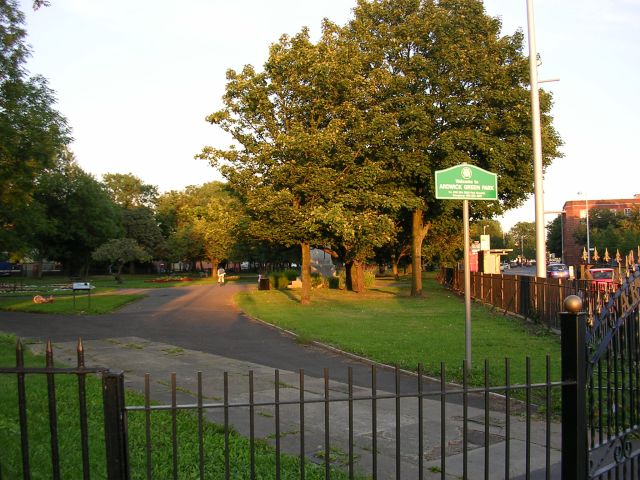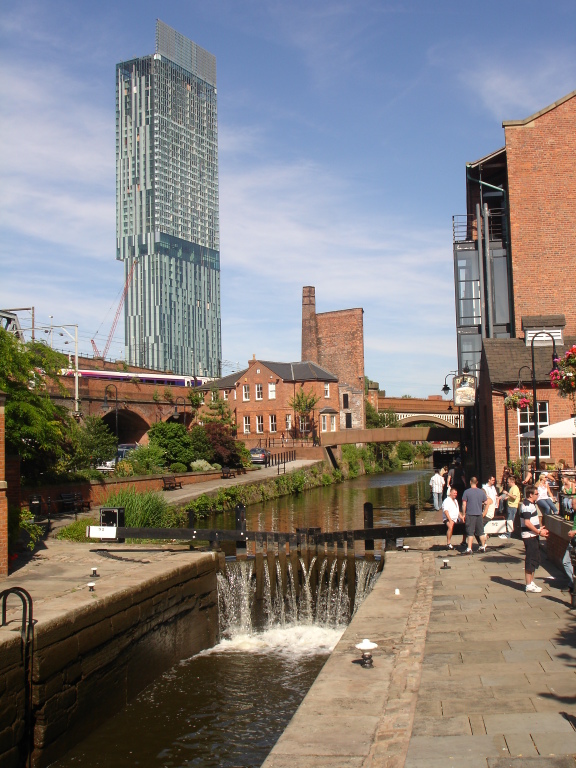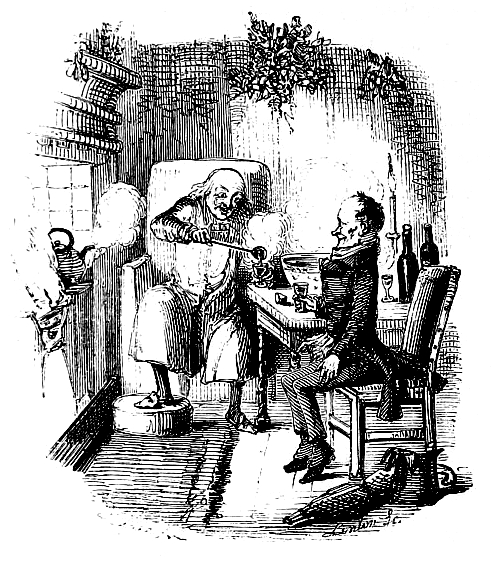|
Ardwick
Ardwick is a district of Manchester in North West England, one mile south east of the city centre. The population of the Ardwick Ward at the 2011 census was 19,250. Historically in Lancashire, by the mid-nineteenth century Ardwick had grown from being a village into a pleasant and wealthy suburb of Manchester, but by the end of that century it had become heavily industrialised. When its industries later fell into decline then so did Ardwick itself, becoming one of the city's most deprived areas. Substantial development has taken place more recently in Ardwick and other areas of Manchester to reverse the decline, notably the construction of many facilities for the 2002 Commonwealth Games held nearby at the City of Manchester Stadium. In the late nineteenth century Ardwick had many places of entertainment, but the only remnant of that history today is the Art Deco-style Manchester Apollo, a venue for pop and rock music concerts. History Prior to the Industrial Revolution, Ardwic ... [...More Info...] [...Related Items...] OR: [Wikipedia] [Google] [Baidu] |
Ardwick Green
Ardwick Green is a public space in Ardwick, Manchester, England. It began as a private park for the residents of houses surrounding it before Manchester acquired it in 1867 and turned it into a public park with an ornamental pond and a bandstand. It contains a cenotaph commemorating the dead of the Eighth Ardwicks, a former unit of the Territorial Army belonging to the Manchester Regiment. The old drill hall at one end of the park is still used by volunteer soldiers. The other end of the park contains a large boulder, a glacial erratic. The Church of St Thomas, on the north side of Ardwick Green, was consecrated as a chapel of ease in 1741. It was rebuilt and extended in the course of the late eighteenth century, and acquired a campanile tower in the 1830s. Many of the grand buildings have been demolished, including the Ardwick Empire Music Hall (later Manchester Hippodrome) at the eastern end. The business premises of Thomas Brown, surveyor and Resident Engineer for the const ... [...More Info...] [...Related Items...] OR: [Wikipedia] [Google] [Baidu] |
Church Of St Benedict, Ardwick
The Church of St Benedict is a redundant church in the Ardwick district of Manchester, England. The church is dedicated to the saint Benedict of Nursia, was designed by J. S. Crowther for a Manchester merchant John Marsland Bennett, and built in 1880. It is generally considered to be Crowther's masterpiece and is a Grade II* listed building. Declared redundant in the early 2000s, the church is now home to the Manchester Climbing Centre. History John Marsland Bennett (1817–1889) was a prosperous stone merchant who served two terms as Mayor of Manchester between 1863 and 1865. He lived at Buile Hall in Salford. Approached to donate land for a church to serve the growing community of Ardwick, he agreed both to provide the site and fund the building of the church. He also selected J. S. Crowther as architect, acted as project manager and took a keen interest in the church liturgy. Construction began in 1877 and the church was complete by 1880. In addition to the church, Crowther bu ... [...More Info...] [...Related Items...] OR: [Wikipedia] [Google] [Baidu] |
Manchester Central (UK Parliament Constituency)
Manchester Central is a United Kingdom Parliament constituencies, parliamentary constituency in Greater Manchester created in 1974 represented in the House of Commons of the United Kingdom, House of Commons of the Parliament of the United Kingdom, UK Parliament since 2012 by Lucy Powell of the Labour Party (UK), Labour Party and Co-operative Party. Constituency profile The seat covers the Manchester city centre, city centre and all its major attractions and both of Manchester's large universities, and fringe areas such as Hulme and Ancoats which have undergone extensive regeneration since the 1990s, an example of which is the New Islington development. Flats in the city centre can sell for several million pounds while there are more deprived areas to the east, including Moston, Beswick and Ardwick. There is a high proportion of graduates and students in the city centre, and the constituency as a whole has the highest proportion of Chinese people in the country. Moss Side is ho ... [...More Info...] [...Related Items...] OR: [Wikipedia] [Google] [Baidu] |
Thomas Potter (mayor)
Sir Thomas Potter (5 April 1774 – 20 March 1845) was an English industrialist and Liberal politician, and the first Mayor of Manchester. Early life Thomas Potter born on 5 April 1774 in Tadcaster, Yorkshire, the seventh of nine children of Anne Hartley and John Potter, a draper. His brothers were Richard who became MP for Wigan, and William. His father, John Potter, was born on 7 December 1728 in Tadcaster and died there on 28 November 1802. He is buried in grave 40655 at St Mary the Virgin's Church in Tadcaster. He worked as a journeyman in London and on the death of his father, also John Potter, on 16 June 1758, and his mother, Anne, on 2 May 1762, he succeeded to their draper's shop in Tadcaster. John took a farm at Wighill where he dealt in sheep and wool. On 23 December 1785 an indenture was made for the lease of Wingate Hill Farm between Sir Walter Vavasour and John Potter "The produce of it (Wingate Hill Farm) having been successively on the advance, his shop, too, ... [...More Info...] [...Related Items...] OR: [Wikipedia] [Google] [Baidu] |
Manchester Apollo
The O2 Apollo Manchester (known locally as The Apollo and formerly Manchester Apollo) is a concert venue in Ardwick Green, Manchester, England. It is a Grade II listed building, with a capacity of 3,500 (2,514 standing, 986 seats). History The building was designed by architects Peter Cummings, Alex Irvine, and R. Gillespie Williams, in an Art Deco style. The building’s frontage consists of a glazed white terracotta façade. Its original purpose was as a multi-purpose cinema and variety hall and was opened by actress Margaret Lockwood. In the 1970s, it stopped presenting films and became solely a concert venue. It also hosts seated events to a capacity of 2,693. Split into two levels, the upstairs contains permanently fitted seating, whereas the larger downstairs can be altered to suit the event; both levels view a single concert stage. The venue has no air-conditioning except in the "Whiteroom" hospitality area. The venue hosts a large number of popular music-based conce ... [...More Info...] [...Related Items...] OR: [Wikipedia] [Google] [Baidu] |
John Dalton
John Dalton (; 5 or 6 September 1766 – 27 July 1844) was an English chemist, physicist and meteorologist. He is best known for introducing the atomic theory into chemistry, and for his research into colour blindness, which he had. Colour blindness is known as ''Daltonism'' in several languages, being named after him. Early life John Dalton was born into a Quaker family in Eaglesfield, near Cockermouth, in Cumberland, England. His father was a weaver. He received his early education from his father and from Quaker John Fletcher, who ran a private school in the nearby village of Pardshaw Hall. Dalton's family was too poor to support him for long and he began to earn his living, from the age of ten, in the service of wealthy local Quaker Elihu Robinson. Early career When he was 15, Dalton joined his older brother Jonathan in running a Quaker school in Kendal, Westmorland, about from his home. Around the age of 23, Dalton may have considered studying law or medicin ... [...More Info...] [...Related Items...] OR: [Wikipedia] [Google] [Baidu] |
Ernest Charles Jones
Ernest Charles Jones (25 January 181926 January 1869) was an English poet, novelist and Chartist. Dorothy Thompson points out that Jones was born into the landed gentry, became a barrister, and left a large documentary record. "He is the best-remembered of the Chartist leaders, among the pioneers of the modern Labour movement, and a friend of both Marx and Engels." Early life Jones was born on 25 January 1819 in Berlin, while his parents were visiting the Prussian court. He was the son of a British Army Major named Charles Gustavus Jones, equerry to the Duke of Cumberland, afterwards King of Hanover. In 1838 Jones came to England, and in 1841 published anonymously ''The Wood-Spirit'', a romantic novel. This was followed by some songs and poems. He entered the Middle Temple in 1841 and on 20 April 1844 he was called to the bar. Chartism In 1845, he joined the Chartist agitation, quickly becoming its most prominent figure, and vigorously carrying on the party's campaign on ... [...More Info...] [...Related Items...] OR: [Wikipedia] [Google] [Baidu] |
Manchester City Centre
Manchester City Centre is the central business district of Manchester in Greater Manchester, England situated within the confines of Great Ancoats Street, A6042 Trinity Way, and A57(M) Mancunian Way which collectively form an inner ring road. The City Centre ward had a population of 17,861 at the 2011 census. Manchester city centre evolved from the civilian ''vicus'' of the Roman fort of Mamucium, on a sandstone bluff near the confluence of the rivers Medlock and Irwell. This became the township of Manchester during the Middle Ages, and was the site of the Peterloo Massacre of 1819. Manchester was granted city status in 1853, after the Industrial Revolution, from which the city centre emerged as the global centre of the cotton trade which encouraged its "splendidly imposing commercial architecture" during the Victorian era, such as the Royal Exchange, the Corn Exchange, the Free Trade Hall, and the Great Northern Warehouse. After the decline of the cotton trade and the Ma ... [...More Info...] [...Related Items...] OR: [Wikipedia] [Google] [Baidu] |
Tiny Tim (A Christmas Carol)
:; Timothy "Tiny Tim" Cratchit is a fictional character from the 1843 novella ''A Christmas Carol'' by Charles Dickens. Although seen only briefly, he is a major character, and serves as an important symbol of the consequences of the protagonist's choices. Character overview Tiny Tim is the young, ailing son of Bob Cratchit, Ebenezer Scrooge’s underpaid clerk. When Scrooge is visited by the Ghost of Christmas Present he is shown just how ill the boy really is (the family cannot afford to properly treat him on the salary Scrooge pays Cratchit). When visited by the Ghost of Christmas Yet to Come, Scrooge sees that Tiny Tim has died. This, and several other visions, led Scrooge to reform his ways. At the end of the story, Dickens makes it explicit that Tiny Tim does not die, and Scrooge becomes a "second father" to him. In the story, Tiny Tim is known for the statement, "God bless us, every one!" which he offers as a blessing at Christmas dinner. Dickens repeats the phrase at the ... [...More Info...] [...Related Items...] OR: [Wikipedia] [Google] [Baidu] |
Manchester
Manchester () is a city in Greater Manchester, England. It had a population of 552,000 in 2021. It is bordered by the Cheshire Plain to the south, the Pennines to the north and east, and the neighbouring city of Salford to the west. The two cities and the surrounding towns form one of the United Kingdom's most populous conurbations, the Greater Manchester Built-up Area, which has a population of 2.87 million. The history of Manchester began with the civilian settlement associated with the Roman fort ('' castra'') of ''Mamucium'' or ''Mancunium'', established in about AD 79 on a sandstone bluff near the confluence of the rivers Medlock and Irwell. Historically part of Lancashire, areas of Cheshire south of the River Mersey were incorporated into Manchester in the 20th century, including Wythenshawe in 1931. Throughout the Middle Ages Manchester remained a manorial township, but began to expand "at an astonishing rate" around the turn of the 19th century. Manchest ... [...More Info...] [...Related Items...] OR: [Wikipedia] [Google] [Baidu] |
Grade II Listed
In the United Kingdom, a listed building or listed structure is one that has been placed on one of the four statutory lists maintained by Historic England in England, Historic Environment Scotland in Scotland, in Wales, and the Northern Ireland Environment Agency in Northern Ireland. The term has also been used in the Republic of Ireland, where buildings are protected under the Planning and Development Act 2000. The statutory term in Ireland is " protected structure". A listed building may not be demolished, extended, or altered without special permission from the local planning authority, which typically consults the relevant central government agency, particularly for significant alterations to the more notable listed buildings. In England and Wales, a national amenity society must be notified of any work to a listed building which involves any element of demolition. Exemption from secular listed building control is provided for some buildings in current use for worship, ... [...More Info...] [...Related Items...] OR: [Wikipedia] [Google] [Baidu] |
A Christmas Carol
''A Christmas Carol. In Prose. Being a Ghost Story of Christmas'', commonly known as ''A Christmas Carol'', is a novella by Charles Dickens, first published in London by Chapman & Hall in 1843 and illustrated by John Leech. ''A Christmas Carol'' recounts the story of Ebenezer Scrooge, an elderly miser who is visited by the ghost of his former business partner Jacob Marley and the spirits of Christmas Past, Present and Yet to Come. After their visits, Scrooge is transformed into a kinder, gentler man. Dickens wrote ''A Christmas Carol'' during a period when the British were exploring and re-evaluating past Christmas traditions, including carols, and newer customs such as Christmas cards and Christmas trees. He was influenced by the experiences of his own youth and by the Christmas stories of other authors, including Washington Irving and Douglas Jerrold. Dickens had written three Christmas stories prior to the novella, and was inspired following a visit to the Field Lan ... [...More Info...] [...Related Items...] OR: [Wikipedia] [Google] [Baidu] |


.jpg)





